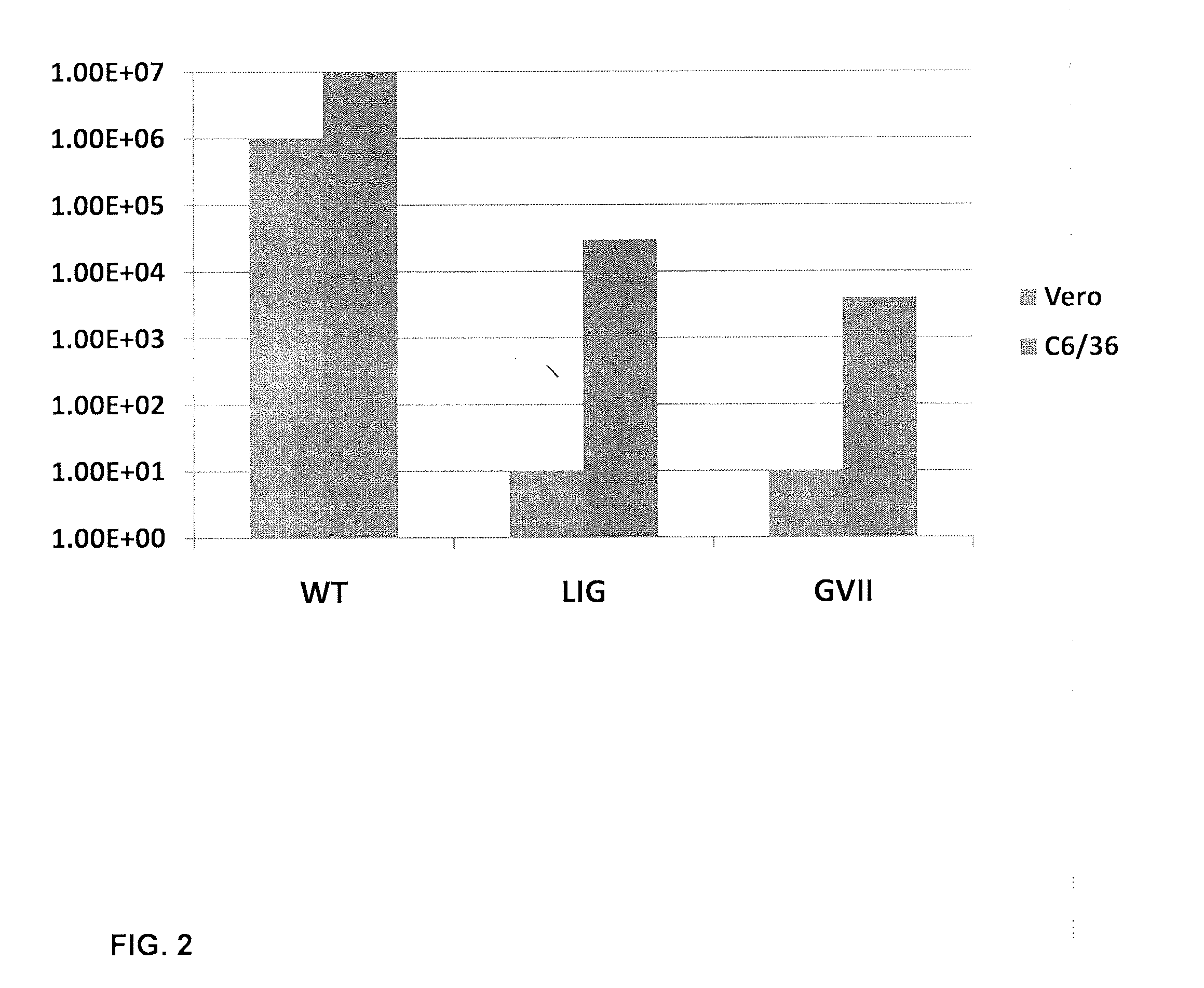Flavivirus host range mutations and uses thereof
a virus and host range technology, applied in the field of mutated arthropod vectored viruses, can solve the problems of virus not being able to infect, virus may not be able to produce progeny in mammalian cells, virus may not be able to infect, etc., and achieve the effect of being readily understandabl
- Summary
- Abstract
- Description
- Claims
- Application Information
AI Technical Summary
Benefits of technology
Problems solved by technology
Method used
Image
Examples
example 1
Host Range Mutants of DV2
Deletion mutants constructed around a specific TMD position / region exhibit host range phenotype. Two mutants DV2ΔLIG and DV2ΔGVII showed host range phenotype restricted to preferential growth in the insect cells (FIG. 2). Mutant viruses with preferential growth in the C6 / 36 mosquito cell line and attenuated growth in Vero cells as defined by at least 2 orders of magnitude less virus production are considered to have host range phenotype. The deletion mutants infected both Vero and C6 / 36 cells at a known MOI with a titer >104 FFU / ml. The Vero and C6 / 36 cells were infected with the mutants at MOI ˜0.03 FFU / cell. The mutant viruses were grown in each cell line, harvested on day 7 and titered on Vero cells, and showed the host range phenotype. The WT DV2 routinely generates titers of 106 ffu / ml in Vero cells and 107 ffu / ml in C6 / 36 cells. Titers were in the range of 103-104 ffu / ml for both DV2ΔGVII and DV2ΔLIG mutants grown in C6 / 36 cells (FIG. 2).
Expression and...
example 2
Clinical Results Using Host Range Mutant Viruses as a Novel Dengue Virus-2 Vaccine
To evaluate the immunogenicity, safety, and efficacy of a vaccine against DEN2, immunization experiments were performed in African green monkeys. African green monkeys provide a useful model for the preclinical assessment of novel candidates for Dengue vaccines (Martin et al., 2009a; Martin et al., 2009b).
Study design. In the present study, serum samples were collected and clinical observations made at baseline and at 1, 3, 5, 7, 14, 30 and 57 days after vaccine administration (Table 4). After serum collection on day 57 animals received live DEN-2 challenge virus (strain S16803 wild type; 105 PFU per animal) before continued serum collection and clinical observations at 58-64, 71 and 142 days post-vaccine administration. All animals were prescreened for the presence of anti-Denguel-4 IgM or IgG by ELISA. Monkeys positive by ELISA were excluded from the study.
TABLE 4Study designStudyplasma volumedayEven...
PUM
| Property | Measurement | Unit |
|---|---|---|
| diameter | aaaaa | aaaaa |
| volume | aaaaa | aaaaa |
| pH | aaaaa | aaaaa |
Abstract
Description
Claims
Application Information
 Login to View More
Login to View More - R&D
- Intellectual Property
- Life Sciences
- Materials
- Tech Scout
- Unparalleled Data Quality
- Higher Quality Content
- 60% Fewer Hallucinations
Browse by: Latest US Patents, China's latest patents, Technical Efficacy Thesaurus, Application Domain, Technology Topic, Popular Technical Reports.
© 2025 PatSnap. All rights reserved.Legal|Privacy policy|Modern Slavery Act Transparency Statement|Sitemap|About US| Contact US: help@patsnap.com



